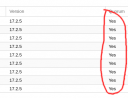I had the same problem today, but a manual creation of the monitor with the ceph built in commands did not help.
It is described here
https://docs.ceph.com/en/latest/rados/operations/add-or-rm-mons/#adding-a-monitor-manual ... but in my case the result was the same as creating the monitor with the proxmox tools.
After several hours I want to share my solution... I hope it helps others tro save some time ;-)
The short version: the solution was to inject a monmap into the stale monitor:
https://docs.ceph.com/en/latest/rad...ing-mon/#recovering-a-monitor-s-broken-monmap
The long version:
1.) Remove all of the stale monitors components and data manually:
pveceph mon destroy ceph-mon@myhost ... results in an error described above "no such monitor id "!
Code:
# stop and disable and remove service
service ceph-mon@myhost stop
systemctl disable ceph-mon@myhost
systemctl daemon-reload
# delete the datadir of the monitor
rm -r /var/lib/ceph/mon/ceph-myhost
#adjust /etc/ceph/ceph.conf manually
# delete IP of stale monitor
mon_host = xx.0.99.83 xx.0.99.82 xx.0.99.84
=> mon_host = xx.0.99.83 xx.0.99.82
# delete the section
[mon.myhost]
public_addr = xx.0.99.84
2.)
After that I was able to add the monitor again with gui or cmdline
Code:
# on the missing monitor host
pveceph createmon
But the monitor could not join the cluster... I tried it again and again, in the logs (var/log/ceph/
ceph-mon@myhost.log there
Code:
2021-05-11 16:37:47.465 7fdf7c47d700 -1 mon.myhost@-1(probing) e13 get_health_metrics reporting 11 slow ops, oldest is log(1 entries from seq 1 at 2021-05-11 16:33:35.201786)
2021-05-11 16:37:50.321 7fdf7e481700 1 mon.myhost@-1(probing) e13 handle_auth_request failed to assign global_id
2021-05-11 16:37:50.373 7fdf7e481700 1 mon.myhost@-1(probing) e13 handle_auth_request failed to assign global_id
A nice feature is to query the admin port of the stale monitor and query the monitor status direct from the monitor, this helps for a better understanding...
Code:
#get the admin socket patch
ceph-conf --name mon.myhost --show-config-value admin_socket
# possible commands of the monitor
ceph --admin-daemon /var/run/ceph/ceph-mon.myhost.asok help
# query monitor status
ceph --admin-daemon /var/run/ceph/ceph-mon.myhost.asok mon_status
Details can be found here
https://docs.ceph.com/en/latest/rados/troubleshooting/troubleshooting-mon/#understanding-mon-status
3.)
The only working solution for me to bring the monitor back in the cluster again was to "Inject a monmap into the monitor" as described here
https://docs.ceph.com/en/latest/rad...ing-mon/#recovering-a-monitor-s-broken-monmap
With a manual permission fix!
Code:
# login to a working monitor host, stop the service and extract the map
service ceph-mon@myworkinghost stop
ceph-mon -i myworkinghost --extract-monmap /tmp/monmap
2021-05-11 16:44:04.119 7f6087bd6400 -1 wrote monmap to /tmp/monmap
#start the service again and transfer it to the stalehost
service ceph-mon@myworkinghost start
scp /tmp/monmap mystalehost:/tmp/monmap
# on the stale monhost, stop the monitor and inject tthe mapstoppen und injecten
service ceph-mon@mystalehost stop
ceph-mon -i mystalehost --inject-monmap /tmp/monmap
# after that the access rights must be set manually fopr the user "ceph" (there where file permission denied errors, becuase after the injection some files belonged to root)
chown ceph.ceph /var/lib/ceph/mon/ceph-mystalehost/store.db/*
# and start again
service ceph-mon@mystalehost start


